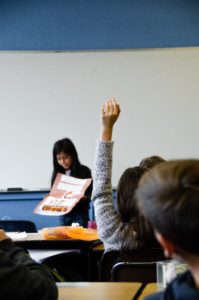For this evaluation of a multimedia app, I decided to research Seesaw. Seesaw is an app that students, teachers and families can use to show learning, gain insights and build connections. While reviewing Mayer’s Principles of Multimedia Learning, I found that Seesaw demonstrates a few of the principles. For example, the voice principle described by Mayer (2014) explains that students learn better when words are spoken in a human voice opposed to a machine voice. Seesaw allows teachers to create activities and provide written and voice instructions in their own voice, which would satisfy this principle. This instruction feature as well as the material posted in video format (ex. a story being told) also follows the segmenting principle, which explains that students learn better when information is presented and the learner can take it at their own pace. Ultimately, Seesaw is a multimedia learning tool that demonstrates student process and product and follows the multimedia principle that people learn better when words and pictures are presented. This video explains how Seesaw works and some of the benefits of using it:
Multimedia and Interactive Learning Evaluation Rubrics:
 While reviewing this app, I evaluated it using the SAMR model and was able to make connections to their criteria of integrating technology into a classroom. For example, their “substitution” criteria explains that you should ask yourself what is gained by using this technology vs. traditional methods (ex. pen and paper). I would argue that students can demonstrate their learning in a way that you cannot see as clearly in a traditional way. For example, students working on a math problem are able to take a video of themselves working through the problem.
While reviewing this app, I evaluated it using the SAMR model and was able to make connections to their criteria of integrating technology into a classroom. For example, their “substitution” criteria explains that you should ask yourself what is gained by using this technology vs. traditional methods (ex. pen and paper). I would argue that students can demonstrate their learning in a way that you cannot see as clearly in a traditional way. For example, students working on a math problem are able to take a video of themselves working through the problem.
Personal Experience:
Seesaw reminds me of an app that I researched for EDCI 336 called FreshGrade. Both apps focus on connecting students, teachers and families with student work, however Seesaw seems to be more hands-on for the students than FreshGrade. From my research on FreshGrade it seemed like teachers were using it more to show work from the students by taking photos/videos and uploading it for parents to see. Seesaw allows students to show their creativity with the built in canvas, drawing, video, picture and audio tools.
Additionally, this app allows students to build a digital portfolio and develop an understanding of the concept of portfolios at a young age. With BC schools adapting the proficiency scale grading system, it seems as though an app like this is a step in the right direction that will allow students and teachers to track student progress.
 My overall experience while using this app was positive. It seemed to be user-friendly and I liked being able to look at other activities posted by teachers to get inspired. I also think an app like this would work well for remote learning, as students can review the materials posted by the teachers and submit their work within the app. Another feature that caught my attention was that the app allows you to import work directly from Google Drive. If you are trying to create a portfolio and want to include something from another document outside the program this seems like a useful tool. Other benefits that I came across are that it can be used for a variety of ages, multiple subjects and student collaboration.
My overall experience while using this app was positive. It seemed to be user-friendly and I liked being able to look at other activities posted by teachers to get inspired. I also think an app like this would work well for remote learning, as students can review the materials posted by the teachers and submit their work within the app. Another feature that caught my attention was that the app allows you to import work directly from Google Drive. If you are trying to create a portfolio and want to include something from another document outside the program this seems like a useful tool. Other benefits that I came across are that it can be used for a variety of ages, multiple subjects and student collaboration.
References:
FreshGrade (n.d). Retrieved from https://freshgrade.com/
Mayer, R. (2014). Introduction to Multimedia Learning. Retrieved from https://www-cambridge-org.ezproxy.library.uvic.ca/core/books/cambridge-handbook-of-multimedia-learning/introduction-to-multimedia-learning/DCB47795DE7396B0CDF134B54F03F6A5/core-reader
Schoology. (n.d.). SAMR Model: A Practical Guide for EdTech Integration. Retrieved from https://www.schoology.com/blog/samr-model-practical-guide-edtech-integration
Seesaw. (n.d.). Retrieved from https://web.seesaw.me/
Good job!